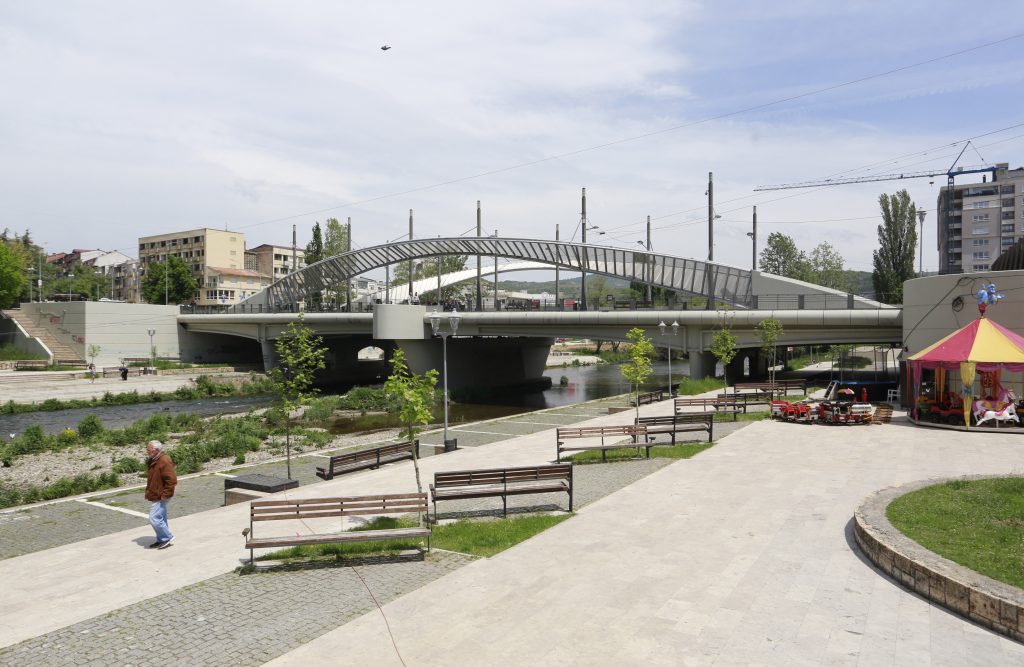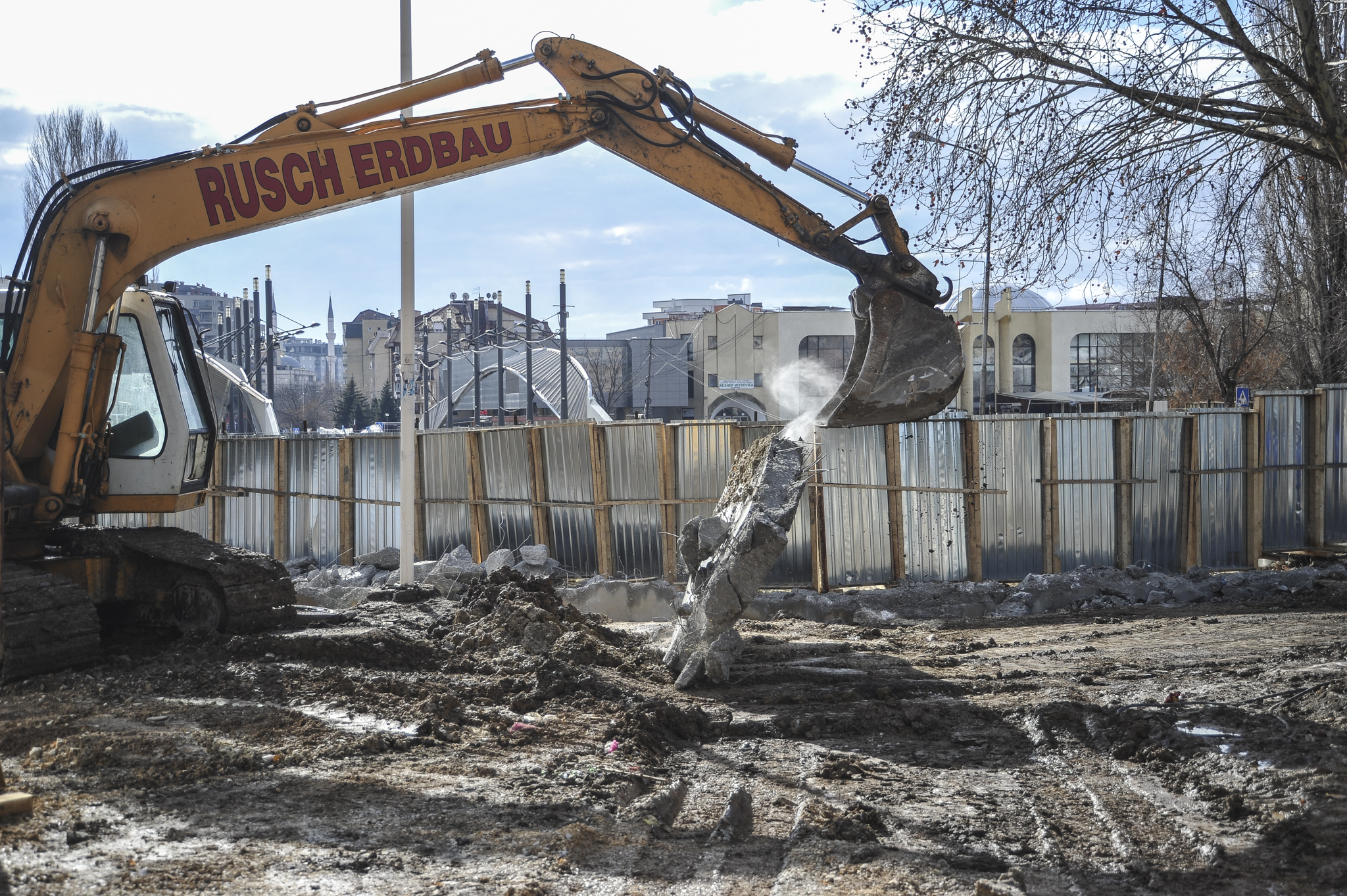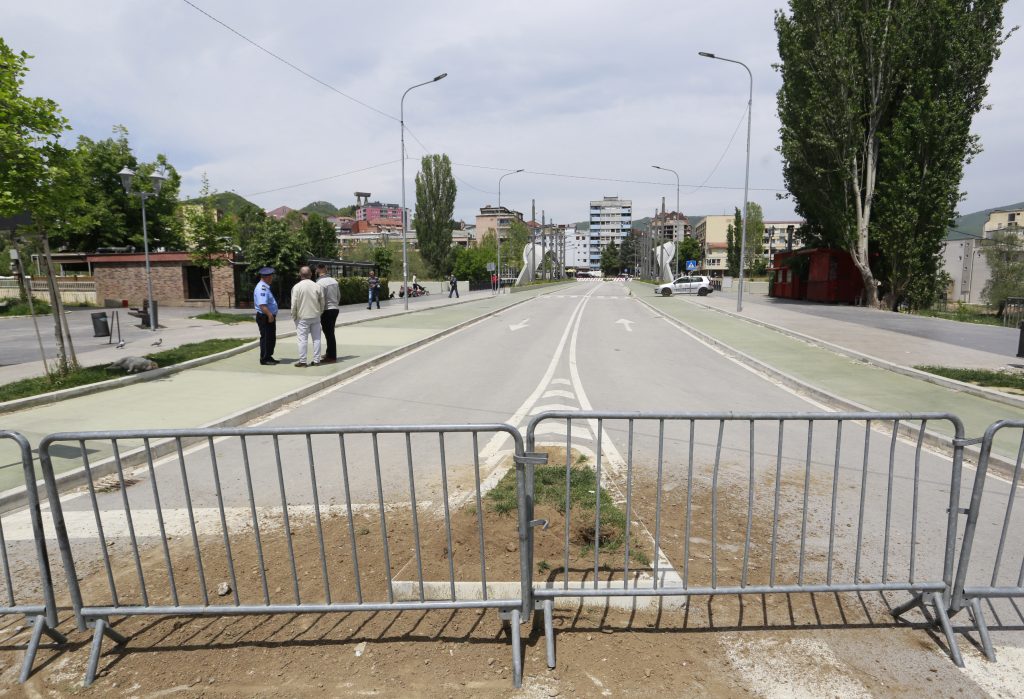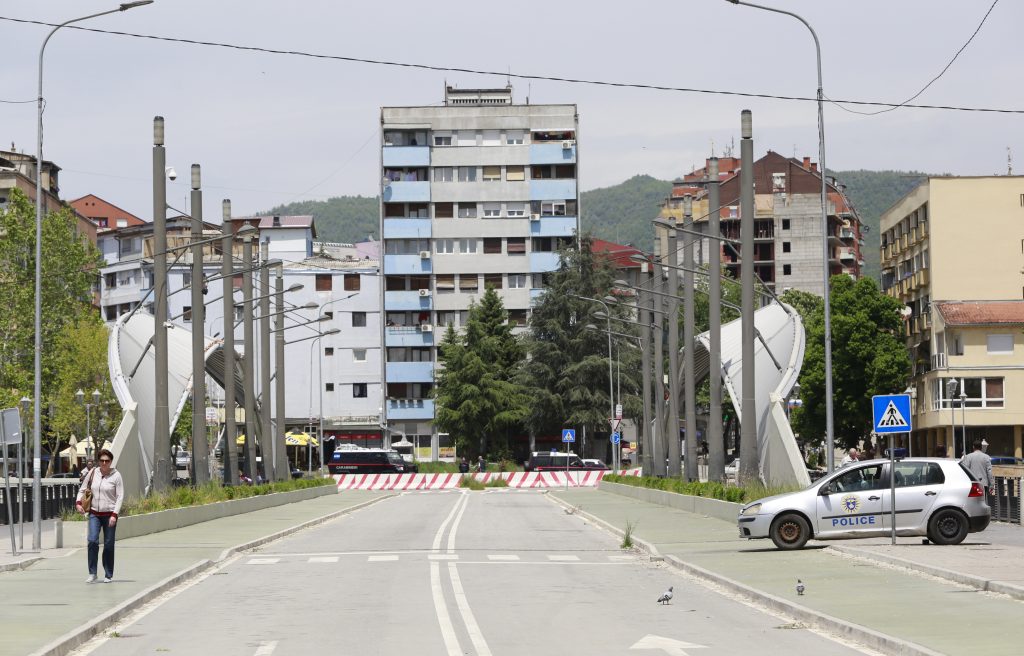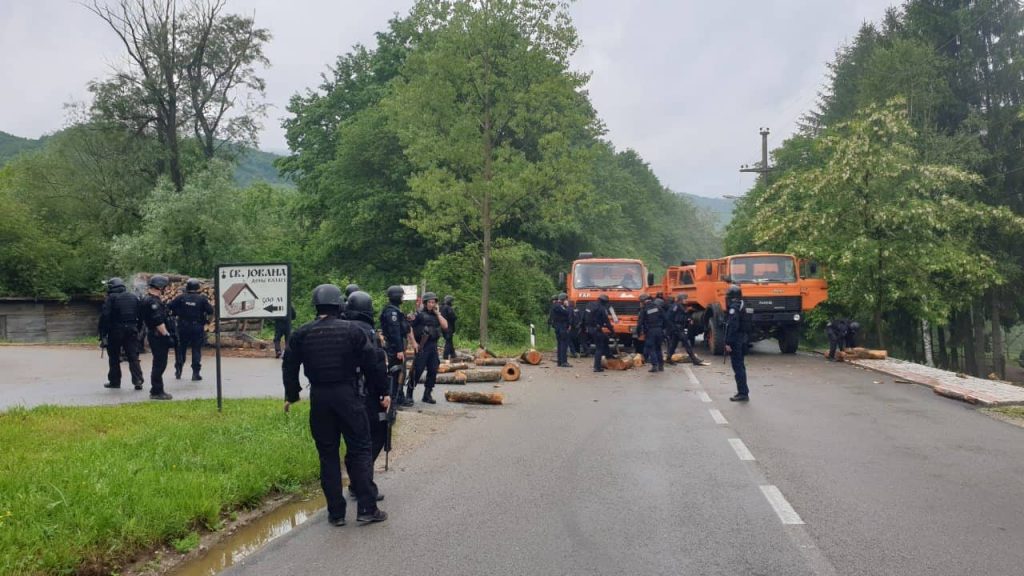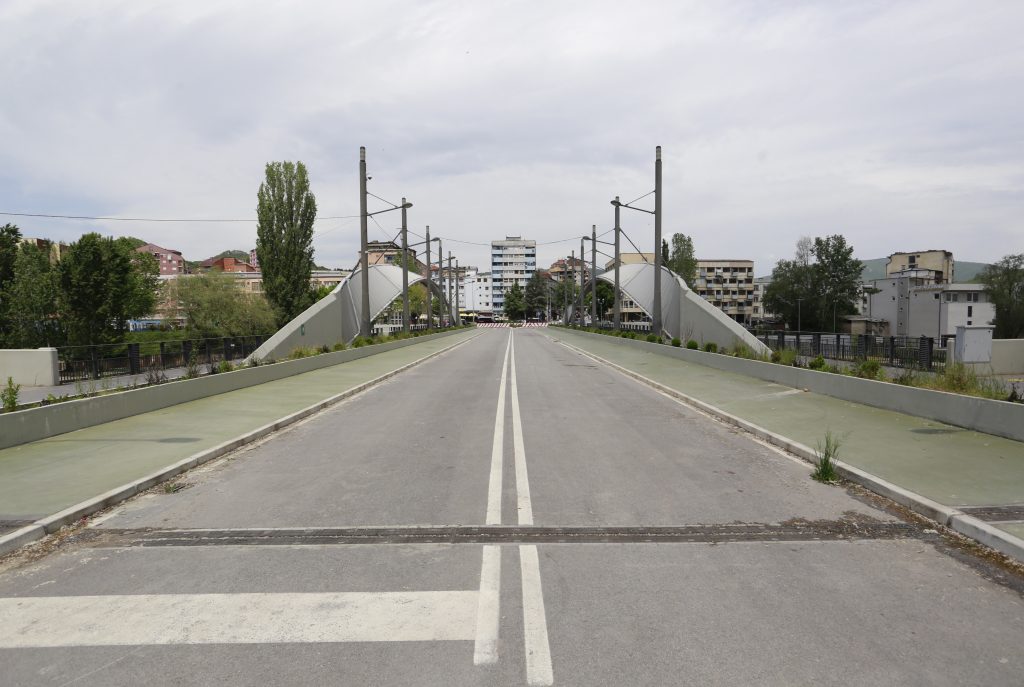The bridge that connects the two sides of the divided city of Mitrovica remains dysfunctional, and while relations between Serbs and Albanians have improved, fears over security persist, largely fueled by political incidents and the threat of organized crime.
The name the French have given to the bridge that has divided the city of Mitrovica for 20 years has emerged to be very fitting indeed. The bridge over the Ibar River or, as the French KFOR soldiers baptized it, “Austerlitz”, in reference to a bloody battle of the Napoleonic wars, continues to be a symbol of ethnic division between Albanians and Serbs and, often, a scene of bloody clashes.
The several-year spiral of violence surrounding the bridge has stopped, but the political battle for its opening is not yet over, and political instability, inter-ethnic incidents, and organized crime are still considered the greatest security risks in northern Kosovo.
While trust in institutions and politicians is declining, there is an increase in interethnic trust between Serbs and Albanians, demonstrated in the frequent contact between, and common experiences shared, by people on both sides of the river.
Fragile Security
The appearance of the bridge has changed over the years. From the gravel stones and the pines of the so-called ‘Peace Park’ and the two-meter-high wall, the area around the bridge is about to be transformed into a promenade.
However, the last hindrance has still not been removed, making it impossible to fully functionalise and integrate the two sides of the city, while deadlines for opening the bridge have been overshot several times.
The revitalization work on the bridge was undertaken by the European Union. At the beginning of the bridge from the south as well as in the area where the road ends, the only pedestrian square, two Italian KFOR patrols stand guard. A few meters further on, the Kosovo police maintain a static position. Many policemen are seen patrolling on foot in every part of the city in the north.
Dozens of parked cars now stand in the space where the wall was once established. The steel structures above the bridge are in place, including street lighting, greenery, and other urban flourishes. But the pile of cobblestones that should have been laid along the “King Peter” square by the Municipality of North Mitrovica remain in boxes.
At the European Union Office, officials have said that, technically, the works they were supposed to carry out have been completed, but there is no date set for the opening of the bridge being inaugurated. “The works for the revitalization of the main bridge and the surrounding area in Mitrovica are technically completed. All dialogue agreements, including the one related to the main bridge, should be implemented as a whole and as soon as possible,” the EU information office stated.
But the non-completion of works does not prevent citizens from enjoying the sunlight on an April day in the unfinished square near the main bridge. From the bridge linking the two Mitrovicas to the border crossing at Jarinje, the distance is over 50 kilometers, and North Mitrovica is the main administrative, business and university center for Serbs in the region, as well as some other minorities.
In the Bosniak neighborhood in North Mitrovica there is a series of premises where Serbs, Albanians, Bosnians, and Turks ply their trade. But an unexpected development could turn the area into a conflict zone and source of tensions within a few minutes, as has happened in the past.
Even the Kosovo Police Department in the north, established after the 2013 Brussels agreement, are aware of this. Deputy Police Commander in the north, Besim Hoti, believes that, despite the decline in the number of inter-ethnic incidents, security in the north is dictated by other developments, especially those with a political hue.
“Incidents, which have mainly been of a political character, continue to happen sporadically, and this creates an imbalance regarding the security situation in the north,” Hoti said. “However, today there is mobility and it is not a problem of who moves from north to south and vice versa, either on foot or by vehicle.”
However, according to him, there are still groups of young people who try to destabilize the situation and cause problems. He has mentioned several cases of clashes near the statue of Car Lazar on the northern side of the city. Extremely serious cases have occurred when young people of different ethnic backgrounds from the north and south have agreed the venues of clashes via social networks in advance.
Such clashes have occurred in the past, some with serious consequences due to the use of cold weapons and tools. “We have managed to prevent some of them by arresting groups of young people from both sides. This has resulted in such cases being minimized, but not stopping them completely,” Hoti pointed out.
Due to the sensitivity of the situation and the use of incidents for political purposes, Hoti says the police activity in the north is focused on prevention.
According to him, some individuals provoke situations to trigger a reaction from the other side. “There have been cases when, for a 10-euro payment, a young man has written nationalistic graffiti, without being aware of the consequences,” Hoti explained. “In this regard, it is important to pay attention to the education of young people. We consider the citizens as our main partner.”
Besides northern Mitrovica, the department also covers the municipalities of Leposavic, Zvecan and Zubin Potok. Police stations have also been opened in mixed areas, such as the one in the village of Caber in Zubin Potok.
On September 11, 2010, after the semi-final of the World Basketball Championship in which Turkey won over Serbia, there was a clash on the Ibar bridge. Five Serbs and one EULEX officer were injured, while several Kosovo police and EULEX police vehicles were also set on fire.
“This could have been an inflammatory point of ethnic tensions. Even now we have the authority to set limitations if we consider that security can be compromised, and we have acted on several occasions,” Hoti said.
The epicenter of tensions
Historically, the bridge has been a source of tensions and conflicts. In September 2009, it was partially reopened for traffic, reinforced with domestic and international police forces.
But the bridge was blocked with stones and gravel by local Serb residents in July 2011 as a sign of opposition to Prishtina’s attempts to establish its authority in the north of the country by taking control of the border points in Jarinje and Bernjak, which are located on the border with Serbia. A Kosovo special unit police officer was killed in this action.
After the removal of the stones and gravel, citizens from the north built a so-called ‘Peace Park.’ This park, which replaced the barricade, left the bridge free for only a few hours. But, in another agreement, the parties came to the conclusion that the park’s barricades should be removed and the revitalization of the bridge be made by the European Union.
Tensions were soon restored when the Municipality of North Mitrovica built a two-and-a-half-meter high wall in the middle of the road leading from the bridge. To avoid the use of force from Prishtina, citizens of the northern half of Mitrovica demolished it in February 2016, after a multilateral agreement between the Kosovo government, the municipality of North Mitrovica, the European Union and the United States of America was reached.
At the same time, the EU and the local government in the north resumed works on King Peter Square, but some incidents near the Car Lazar statue in 2017 were taken as a pretext to stop the excavators again.
The fifth point of the agreement on free movement has nothing to do with the bridge, where implementing parties are defined as the local authorities in Mitrovica and the Government of Kosovo. However, setting the administrative boundary between North Mitrovica and South Mitrovica has remained hostage to the north’s claim that Suhodoll shall be included within its borders.
Based on the Comprehensive Proposal for the Kosovo Status Settlement, known as the Ahtisaari Plan, the city of Mitrovica was divided into two municipalities. This plan, drafted 11 years ago and on the basis of which Kosovo declared its independence, specified that two new municipalities had to be established, with municipal boundaries defined in an annex to this document.
The annex indicates that the northern municipality consists of three cadastral zones: North Mitrovica, Upper Suhodoll and Lower Suhodoll; while Suhodoll itself was not included. Even in the Law on Boundaries of Municipal Administrations, the same cadastral zones are defined in North Mitrovica and Suhodoll is defined as the southern municipality.
Parallel Realities
Outside of policy and dialogue in Brussels, a number of local initiatives have been undertaken in favor of conflict resolution and reconciliation.
Miodrag Milicevic heads the largest non-governmental organization in the north, while Zana Syla is the program manager at the Multiethnic Center for Alternative Conflict Resolution. As two citizens on this side who have experienced a sense of insecurity, they now deal with activities that influence conflict resolution and reconciliation.
In 2010, Milicevic was the subject of attack, his car burned in front of the building in which he lived. Since then, the case has not been discarded, nor have the perpetrators been found.
“I completely lost confidence in the police. So far I have received zero information about the case even though I have enquired several times. Nothing has happened,” said Milicevic, who was then working for the OSCE mission in the north.
Despite improvements in recent years, according to Milicevic, there is still uncertainty in the north. Research conducted by his organization reveal a lot about the perception of fear among citizens, which is also demonstrated when it comes to the opening of the Ibar Bridge.
Based on polling from 2018, Serbs from Kosovo’s north continue to be against the opening of the bridge. About 67 per cent of them stated that opening the bridge would have a negative impact on the security situation, while 27 percent say it would not have any impact, and only 4.8 percent think it would have a positive impact.
“We have always stressed that one of the key elements that policymakers have to pay attention to, is the individual fear of inter-ethnic incidents,” Milicevic explains. “At present, no one is worried about it. It is necessary to move and address these issues, as we are losing energy as to when will it be open, and why the bridge is not opening. This is a vicious circle that is hindering us from moving forward.”
Alternative Dispute Resolution Center-Mitrovica Mediation Center (ADRC-MCM) is among the only multi-ethnic organizations based in the Mitrovica region. Its work consists of two main focuses: providing mediation services to citizens of the Mitrovica region and promoting mediation as an alternative to dispute resolution; and, developing projects and implementing activities that, in addition to mediation, also contribute to reconciliation and peace processes in Mitrovica.
From its establishment in 2013 up until April 2019, about 1,400 cases have entered mediation through ADRC-MCM. Over 93 percent of them have been successfully resolved, with more than 3,500 parties having taken part in mediation.
Zana Syla says that, until 2013, communities in the north lived in a parallel reality, different from that experienced in the rest of Kosovo.
According to her, with the Brussels Agreement and the beginning of the integration process, this situation has changed, and a series of steps have been taken towards the involvement of communities, specifically the Serb community, in institutional life and Kosovar society.
However, according to various surveys of citizens from both the north and south of Mitrovica, there is a view that their interests are not represented. Consequently, the effects of this process have been limited.
“Such sentiment and opinion is significantly more present in the Serb community, who have had, and continue to have, a degree of aversion to the whole development, and thus to integration,” Syla says.
When referring to the impact of the Brussels Accords on the security situation, Syla estimates that most participants in their analyses of public opinion — included in the “Beyond the Bridge: Symbolism, Freedom of Movement and Security” report — stated that none of the agreements reached in Brussels have contributed to the security situation.
There are also minimal differences as to how citizens see the impact of these deals on the north and south of the Ibar River, though Albanians in Mitrovica seem to have more confidence in the agreements reached so far.
Albanians in Mitrovica conclude that the agreement on integrating the justice system (with 29.9 percent of respondents) and the agreement on the integration of former MUP officers into the Kosovo Police (with 16.1 percent) are the two agreements that have most affected the security situation in the north.
On the other hand, 72.1 percent of Kosovo Serbs in Mitrovica said that none of the agreements had any significant impact on the security situation in the north. The agreement that has most affected the security situation in the north, according to 12.2 percent of Serb respondents, is the agreement for the integration of former members of the MUP into the Kosovo Police.
“Based on this, it can be noticed that, according to the civic perspective, the security situation has not seen many changes,” Syla said.
Rather than in the security situation, Syla feels the Brussels Agreements and the integration process have contributed to the improvement of inter-ethnic relations.
“The institutions, the market, and society have also encouraged interethnic communication,” Syla added. “Here is the contribution [the Brussels dialogue] has made to improving relations and civil society, organizations such as the Alternative Dispute Resolution Center-Mitrovica Mediation Center (ADRC-MCM), which is one of the only multiethnic organizations in this part of Kosovo.”
The Pledge of Silence
One product of the so-called First Agreement on the Normalization of Relations between Kosovo and Serbia is the Kosovo Serb political party, Srpska Lista.
Any other political parties that have chosen to challenge Srpska Lista are accused by officials in Belgrade as being divisive. As a result, on May 19, when extraordinary mayoral elections were held, Srpska Lista was challenged only by Albanian parties, which are a minority in this area. Even the main political opposition, the Serbian Civic Initiative, whose then-leader was killed in January last year for still undetected reasons, did not participate.
Serbia has not limited its allegations only to political parties. Serbian President Aleksandar Vucic has also accused the media in the north of spying on Serbia and breaking Serbia’s unity, a message delivered while visiting Beijing, China.
This accusation was rejected by Tatjana Lazarevic, the editor of the leading online media in the north, Kossev.info, who spoke of the pressure on media that produce critical news against those in power.
“It was a low kick, an unfair sport. It is unnecessary to mention the irrationality of a politician who subdues the free media in a visible and powerful manner. Moreover, the top state official raised his voice against the free media, which are already working in a difficult environment,” said Lazarevic, who last year received the Personality of the Year 2018 award from the Serbian magazine Vreme.
The KoSSev editorial was declared as the winner of the “Dusan Bogavac” award, which is awarded by independent Serbian journalists for proven ethics and courage, but Lazarevic feels there has not been enough support from outside of Serbia. “I’m not satisfied with the support of the international community, especially those organizations whose mission is to protect free media such as the OSCE and the EU,” she said.
Facilitating Lazarevic’s political pressure was the attention and support of colleagues, civil society organizations and other individuals in Serbia, who “vigorously raised their voices and broadly covered this development.”
According to her, when talking about the reports that are being made on the north of Kosovo, there are many biases, falsehoods, false news or half-truths. “The latter [half-truths] are often used by those media or newspapers that want to believe they are objective and report professionally. Half-truths can often be more dangerous than a lie,” said Lazarevic.
What personally hit her the most in the last 20 years, when talking about northern Kosovo is the lack of the “other side.” The other party, in the journalist’s assessment, is the people themselves.
“Finally, I see a great fear on both sides as well as skepticism towards feeling free to apply a full-information editorial policy. I see the editors frightened or simply ignoring the behavior of many different voices in Kosovo in their newspapers, social media or television. The pledge of silence is still ruling,” she said.
Emergency Alert
Emergency alarms continue to sound whenever Kosovo Police take action in the north. One such incident took place last month when dozens of Serbs responded to the call to deploy barricades in the north, attempting to halt a Kosovo Police action to arrest a number of officials suspected of involvement in the smuggling of goods.
Kosovo Police officers were also attacked with weapons, which resulted in three of them being injured. Serbia dramatized the situation further by threatening military intervention if the Special Units were not withdrawn.
Uncertainty also reigned at the beginning of last year when the most well-known politician in the area, Oliver Ivanovic, was killed in the center of Mitrovica. The perpetrators of this crime have not been disclosed and the case is being investigated by the Serious Crime Department in Prishtina.
Police have failed to capture the main suspect, Milan Radojcic, deputy head of Srpska Lista, a figure related to crime in the north and the leading role of parallel structures.
Besim Hoti says that such actions affect the citizens in terms of their security, but, according to him, police actions in collecting evidence and arrests have been unhindered.
“Every act authorized by the prosecutor has been carried out in the north, starting from searching locations to arrests. We have had cooperation with citizens in developing procedures and collecting evidence for further investigative procedures,” said Hoti.
But Milicevic believes that the high profile violent events have undermined citizens’ confidence in the justice system. “Each of us began asking ourselves, what should we expect if a politician is murdered?” he asked, rhetorically. “Half a year later, no progress has been made in solving the case. It’s a ping-pong game between Kosovo and Serbia. Unfortunately, some media have become tabloids, want to be more exclusive than research. Therefore, in many cases, the situation is hazy.”
Nevertheless, to what extent are the parallel structures, financed by Serbia and that have long exercised effective control in the north present? Police say they are not as present as to directly affect security on a daily basis.
Yet, the situation varies when it comes to political events between Kosovo and Serbia. “The more stable the political level is, the contribution will be greater in increasing security. If you see people walking free on a daily basis, there is no problem regarding this issue. This could not happen five years ago,” Hoti said.
Amnesty of the crimes, the integration of illegal structures…
The Brussels Dialogue also assisted in the integration of parallel structures by giving amnesty to criminal offenses committed by Serbs against Kosovo’s statehood. But many problems have accompanied this process. Out of the 337 former members of the Serbian MUP, 292 of them became part of the Kosovo Police.
One of them is Branislav Radovic, who holds the rank of lieutenant. Though he is not so talkative about the past, he says he is engaged every day to provide security for all citizens, without any distinction.
“The cooperation with colleagues here is splendid, and we have no problems with each other. After all, the goal of all of us is to enable citizens to feel safe in their families and property,” he says.
In accordance with the 2013 agreement on the principles governing the normalization of relations, some actions have been undertaken with the aim of integrating members of the Serbian Civil Defense.
The decision of July 27, 2015 anticipated the dismantling of this structure, which was composed mainly of younger generations. Most of them did not complete high school, and those who completed higher education did so at the University of North Mitrovica, which Prishtina considers as a parallel education institution.
The first group of 483 members, of whom only 25 were women, were integrated into the ministries and government agencies. A second group of 50 people was integrated into 17 central institutions in July 2016.
A challenge for the government has been the integration of 39 of the 71 former members of the Serbian MUP in the civil registry offices in the four northern municipalities. Although the Ministry of Local Government Administration has made the necessary preparations for the integration of these members, according to government reports, northern municipalities are refusing to integrate 39 employees into municipal structures.
Some of these members are still waiting to start their work on behalf of Kosovo’s institutions, yet they continue to receive wages. The Ministry of Economic Development, MED, has paid wages to 18 employees of former Serbian parallel structures without working at all.
Based on the report of the National Audit Office for this ministry, the MED had spent over 92,330 euros on their wages, although they have never worked a day. The Ministry of Health has also spent 97,733 euros on the wages of 22 employees from former Serbian parallel structures without working at all.
Despite this, the European Union Office considers the integration of the police and judiciary in the north a success story.
“The Brussels Agreement has laid the foundations for the integration of the judiciary and the integration of Serbian police officers into Kosovo’s institutions by contributing to the normalization of relations, improving and stabilizing the security sector as a whole, and promoting the rule of law,” the EU office said.
Problems with justice
The Mitrovica Basic Court, established after the agreement on the integration of the judiciary was reached on February 10, 2015, is located on the opposite side of the police station on the north side of Mitrovica. In addition to the Court, a Basic Prosecution Office was also established for the entire Mitrovica region. Besides the four Serb-majority municipalities, the municipalities of Southern Mitrovica, Skenderaj and Vushtrri are also under the jurisdiction of the Prosecution Office.
There are also four departments of the Basic Court: in Zubin Potok, Leposavic, Vushtrri and Skenderaj. This court has a department of the Appellate Court in Mitrovica, consisting of five Serbian judges and two Albanian judges, as well as the Department of Serious Crimes for the entire Mitrovica region, represented by four judges.
This will be part of the general department that will handle all criminal offenses for southern and northern Mitrovica, as well as Zvecan.
There are a number of challenges that institutions continue to face in implementing the justice agreement. Due to the inability to communicate directly with the Serbian authorities, the Government refers to its requests through the EU Special Representative Office.
From October 2014, government requests for legal assistance in civil and criminal cases have been sent through EULEX. The government has also expressed its concerns about seals.
Serbia seals documents with the inscription “The Republic of Serbia – Kosovo and Metohija – under UN administration and the 1244 Resolution.” This seal is placed on the original documents of the courts and other bodies of Kosovo.
Also, it is not yet decided what will happen to the decisions of the parallel courts. This has also been highlighted as a challenge by the OSCE mission.
“As regards to the implementation of the agreement on justice, the main obstacles are, as follows: the recognition of judgments issued by the courts before the integration of the judiciary, delayed allocation of civil cases, insufficient number of translators, and a lack of internet,” said Senad Sabovic, a spokesperson in the OSCE.
This organization has also conveyed its concerns about the security situation in the north.
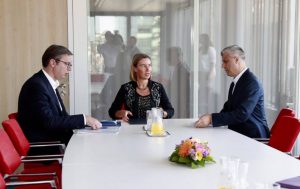
Kosovo President Thaci and Serbian President Vucic meet with High Representative Mogherini in Brussels July 18, 2018. | Photo courtesy of the HRVP Mogherini’s office.
“The very fact that the dialogue in Brussels has stalled causes political tensions. The security situation, in general, has not changed,” said Sabovic. “However, all sides should continue to make efforts to maintain stability, especially in the north where the circumstances are more specific and where the relations between the communities are more difficult.”
The EULEX Mission in Kosovo has its role in implementing the agreements, too. This mission advises the President of the Basic Court of Mitrovica and the head of the Appellate Court Division in Mitrovica, “to ensure that judicial institutions are fully functionalized in the legal framework of Kosovo.”
The EU Rule of Law Mission, which was launched in Kosovo in 2008, facilitates the technical implementation of agreements and protocols achieved during the Brussels dialogue, including the Technical Protocol of the Agreement on Integrated Border Management (IBM), the Arrangements for Freedom of Movement and the Agreement on Justice.
Officials from the mission said that they work closely with the Ministry of Internal Affairs, MIA, the Basic Court of Mitrovica, the Appellate Court Division in Mitrovica and the various Kosovo authorities responsible for implementing the agreements.
Concerning the implementation of the IBM Technical Protocol, EULEX advisors provide technical advice on building joint border crossing points with Serbia, and recently they have supported the drafting of the Integrated Border Management Strategy 2019-2023, the Action Plan and the development plan for the National Border Management Center.
But the process of the joint border crossing point function in Merdare is pending due to Serbia’s refusal to shift to the joint facility as bound by the IBM’s Integrated Border Management Agreement.
A good day is not seen in the morning
According to Tatjana Lazarevic, the pretense of changing the political and social context in the north overnight resulted in a mistake. She says that the Brussels Agreements have not impacted on the enhancement of security, rule of law, nor in the installation of transparency, justice or democracy.
“The opposite happened. For the time being, the process of dialogue and the effective implementation of the agreements reached so far, are blocked. Some of them are still not launched, such as the Association/Community Agreement, which is of particular importance to citizens in areas where Serbs dominate,” said Lazarevic, who, reflecting on the process, believes it is good proof of the maxim that “a good day is not seen in the morning.”
“The political leadership of northern Kosovo was replaced overnight by a series of actions by official Belgrade. Whether someone likes it or not, it is a fact that the will of citizens in the north, who have clearly demonstrated over the years their will to remain disintegrated in the Kosovo system, was brutally ignored,” she said.
For pragmatic reasons, if a high-level political agreement would be made, according to Lazarevic, the least would be for both parties, Prishtina and Belgrade, to open a channel of dialogue and an information campaign to discuss it with the community.
“Moreover, Belgrade’s multi-year policy to support the Serb community in the north against the Kosovo system changed overnight, which was extremely dangerous for the community,” Lazarevic said, pointing to a series of events that took place in 2013/2014.
She recalled how in September 2013, a group of masked bandits destroyed ballot boxes in a North Mitrovica polling station before the voting had ended. Then, backed by the Vucic’s Serbian Progressive Party, Krstimir Pantic resigned just days after being elected mayor.
A mayoral candidate in the race, Dimitrije Janicevic, was murdered during the election campaign on January 16, 2014. Ten days later, another mayoral candidate, Oliver Ivanovic, was arrested as a suspect on war crimes charges, released three to five years later. Ivanovic was later murdered in early 2018, after the second set of local elections in the north.
Finally, the votes from the northern municipalities were not counted in Fushe Kosove, as the procedure requires, but in Raska in southern Serbia.
“What I am trying to say is that a series of terrible crimes and a series of illegal acts took place one after the other, all connected to the elections after the Brussels agreement, and they received no attention. Instead, the electoral process was appraised as regular, applauded by Prishtina, Belgrade and the international community,” Lazarevic said.
Currently, the Brussels dialogue is seeing its lowest point. Consequently, most of the dialogue agreements are blocked, due to the tariff and the clashes between Kosovo and Serbia;s officials.
While pending the resumption of dialogue, civil society organizations have not stopped promoting reconciliation and creating bridges within which members of various ethnic groups engage and work towards conflict resolution.
“It can be concluded that in relation to the security situation, inter-ethnic relations have seen more improvement, and the situation is better than it was. However it is far from the expectations and desired levels,” said Zana Syla.
The issuance of personal identification documents
Providing personal identification documents and functionalizing the Civil Status in the north is another important aspect in terms of security.
Based on the Brussels agreement, on July 5, 2018, the Minister of Internal Affairs issued a decision enabling all citizens who had registered details of their Civil Status (Births, Marriages and Deaths) in illegal Serbian structures between June 10, 1999 and September 14, 2016, to register them in the Central Registry of the Civil Status of Kosovo.
As regards to the Freedom of Movement Agreement, EULEX has said that it supports residents in the northern part of Kosovo having access to their civil status documents, such as identity cards, passports, driving licenses, and vehicle registration documents.
For the purpose of this research, the MIA has provided the available number of documents issued in the four northern municipalities. In North Mitrovica 13,773 ID cards, 1,695 passports and 2,159 driving licenses have been issued, while in Leposavic, 11,125 ID cards were issued, 410 passports and 2,374 driving licenses.
In Zubin Potok, 6,098 citizens are equipped with Kosovo ID cards, 720 with passports, and 1,511 driver licenses have been issued, while in Zvecan there are 6,500 citizens with Kosovo ID cards, 532 with passports and 1,262 with driving licenses.
Meanwhile, the police in the north, say that since the end of 2018, it has undertaken an operational plan for the removal of all vehicles without registration plate numbers and without insurance.
An EU funded project, managed by the European Union Office in Kosovo and implemented by BIRN and AGK.
© KOHA






